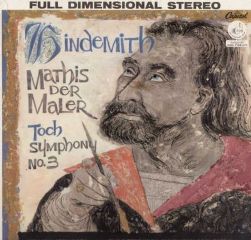Hindemith - Mathis der Maler Toch - Symphony 3 (1957)
Hindemith - Mathis der Maler Toch - Symphony 3 (1957)

Hindemith - Symphony, "Mathis der Maler" 1. I. Engelkonzert (Angelic Concert) 00:08:27 2. II. Grablegung (The Entombment) 00:04:43 3. III. Versuchung des heiligen Antonius (The Temptation of St. Anthony) 00:13:39 4. Ernst Toch - Symphony No. 3, Op. 75 Pittsburgh Symphony Orchestra William Steinberg – conductor
The question of the artist’s role in society is the theme of Hindemith’s opera Mathis der Maler (Mathias the Painter), a fictional account of the life of Mathias Grunewald (c. 1475-1528), who lived during the time of the Peasant’s War in Germany, when serfs revolted against their feudal lords, violently turning society on its head in the name of justice before succumbing to hired professional armies. Hindemith had shown no interest in the subject when his publisher suggested it in 1932, but a year later, after the Nazis had come to power, he immersed himself in the subject and began to write both the music and libretto. Well before finishing the opera, but after he had worked out its major elements, Hindemith put together the Mathis der Maler Symphony. Wilhelm Furtwängler and the Berlin Philharmonic gave it a triumphant premiere in March 1934, but a month later a performance was banned because of reports that Hindemith had made remarks critical of Hitler. Later that year Furtwängler, pleading Hindemith’s case in a Berlin newspaper article, succeeded only in convincing the Nazi leadership that Hindemith was, as propaganda minister Goebbels put it in a December 1934 speech, “drastic confirmation of how deeply the Jewish intellectual infection has eaten into the body of our own people.” Despite the clarity of this hint, Furtwängler and other Hindemith supporters continued to lobby unsuccessfully to allow Mathis to be staged in Germany. Hindemith gradually severed ties with Germany, moving to Switzerland in 1938 and then to the United States in 1940.
Each movement of the Symphony is based on Grunewald’s vivid and sometimes grotesque and bizarre Isenheim altarpiece paintings. The opening Engelkonzert (Angelic Concert, the opera’s overture) is a scene of Mary and the infant Jesus being serenaded by angels. Hindemith’s music depicts the striking lighting of the painting at the opening, with shining G-major chords against rising passages in G minor (this major-minor ambiguity, called “cross-relation,” was a favorite device of Brahms). The trombones introduce Hindemith’s version of medieval German song, Es sungen drei Engel (Three angels were singing). The music emulates the bright colors of the painting with brilliant splashes of sound, and evokes the beating of the angels’ wings with a bird-like theme introduced by the flute, and by chirping eighth-notes in the violins.
The second movement, Grablegung (Entombment), is based on a panel depicting the crucified Jesus being laid in the tomb. It comes from the final scene of the opera, as Grunewald’s last great burst of creation, and his life, come to an end.
The last movement is a wholly symphonic creation using music from the extended climactic scene in the opera, which is based on two of the Isenheim paintings. In one of them, St. Anthony is assailed by grotesque demons (Hindemith’s Anthony/Grunewald is confronted with his life choices in the form of characters from the opera). The other shows St. Anthony meeting St. Paul the Hermit. Shortly before the end of a movement of explosive force and great churning energy, the woodwinds introduce the 13th-century chant “Lauda Sion Salvatorem,” which is answered by majestic alleluias in the brass. — Howard Posner, laphil.com
The Ernst Toch’s Third Symphony was awarded the 1956 Pulitzer Prize for music.
The award was made for original use of new instruments including a Hammond organ, glass balls (instead of a vibraphone), a wooden box containing wooden balls and three horns mounted on a board and fed with compressed air. A witty central movement includes a stiff-legged tip-toe introduction that is to return Tippett-like in the finale. Again the music is modernistic but not outright avant-garde. The final sprint is a display of uproarious virtuosity. It would be interesting to know how this disc compares with the reading by William Steinberg and the Pittsburgh Symphony Orchestra recorded on Capitol shortly after they had premiered it on 2 December 1955. --- Rob Barnett, musicweb-international.com
download: uploaded yandex anonfiles 4shared solidfiles mediafire mega filecloudio nornar
Last Updated (Friday, 10 January 2014 15:50)








